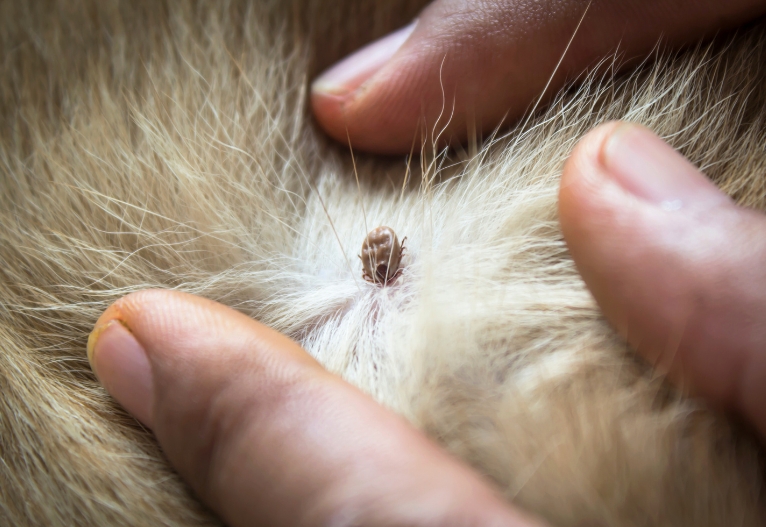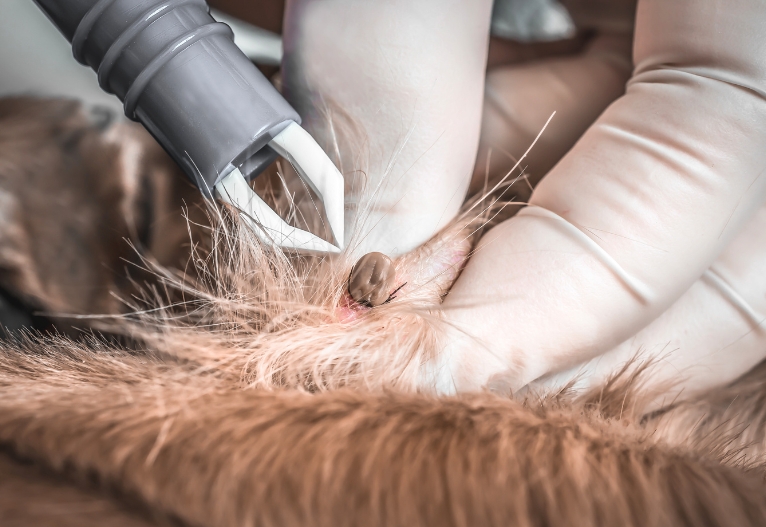If you’ve ever wondered how to spot tick symptoms in dogs and what to do if you find one, here’s what you need to know.

Dr. Liisa Ahlstrom is a veterinarian passionate about pet health, research and education. She began her career working with small animals before teaching veterinary anatomy at The University of Sydney and completing a PhD focused on improving treatments for dogs with skin allergies. Her interest in parasite prevention led her to the animal health industry, where she now works as a Technical Veterinarian at Elanco Animal Health (Seresto), helping pet owners and vets protect dogs from ticks and other harmful parasites.

Ticks are more than just a nuisance, they can pose a serious threat to your dog’s health. From paralysis ticks to the rapidly spreading ehrlichiosis, tick-borne diseases can be life-threatening if not caught early.
While ticks are one of the biggest threats to dogs in Australia, many pet owners aren’t fully aware of the risks. Most people living along Australia’s east coast know about paralysis ticks, but fewer realise the dangers of tick-borne diseases like ehrlichiosis, which has been spreading rapidly across Australia since 2020.
Recognising tick symptoms in dogs, understanding the effects and taking the right preventative steps can make all the difference. In this article, I’ll break down what you need to know about ticks, what to look out for, common myths, and how to keep your dog safe.
How do dogs get ticks?
If your dog spends time outdoors on the east coast of Australia, especially in bushland, but even in suburban parks or your backyard, there’s a chance they could pick up a paralysis tick. These little hitchhikers love to hang out on vegetation, waiting for a passing host to become their next meal.
Brown dog ticks live wherever dogs are, including in kennels and homes, which allows them to spread more easily between pets.

Spotting tick symptoms in dogs
Knowing how to spot a tick on your dog is an important way to protect your pet from illness. Tick symptoms can range from mild to severe, depending on the type of tick and any diseases it may carry. If your dog has been in a tick-prone area or you suspect they may have been exposed, don’t wait for symptoms to worsen, as early treatment can make a huge difference.
Some of the first signs of tick paralysis can be subtle. Your dog might seem quieter than usual or they may become wobbly in their back legs, lose coordination, and eventually be unable to stand or walk. The paralysis can quickly spread through their body, making it harder for them to breathe. You might also notice changes in their bark, making it sound weaker or different than usual.

If your dog has been bitten by a brown dog tick carrying the bacteria Ehrlichia canis (the cause of ehrlichiosis), you may notice that two to three weeks later they become lethargic, unusually quiet, or lose interest in food. A fever can make them feel hot to the touch, and severe cases may lead to dramatic weight loss and eye cloudiness or blindness. Some dogs develop nose bleeds or bleeding under the skin and gums.
If you notice any of these symptoms, or you suspect something seems off with your dog, get them to a vet immediately. Symptoms can progress rapidly, and the sooner treatment begins, the better the chances your dog has of recovery. If possible, call your vet while you’re on the way so they’re ready to act fast when you arrive.
What to do if you find a tick on your dog
If you spot or feel a tick on your dog, stay calm but act quickly. The safest way to remove it is with fine-tipped tweezers or even better, a tick removal tool. With tweezers, get a good grip on the tick close to the skin and pull it out slowly and steadily, twisting as you remove it. If you’re using a tick hook, check out our guide to removing ticks to do this safely and without injuring your dog.
Once you’ve removed the tick, pop it into a sealed bag, label it with the date, and store it in the freezer. If your dog starts showing more serious symptoms later, your vet may want to identify the tick to determine the best course of action. Clean the bite area with saline or pet-friendly antiseptic and keep a close eye on your dog for any changes in their behaviour or health.

If you’ve been unable to completely remove the tick, never attempt to remove it with home remedies like petroleum jelly, nail polish remover or by burning a tick off. These methods are not effective and you could seriously injure your pet. If a small part of the tick remains in the skin, it will likely be expelled naturally over time without causing a problem. In the meantime, keep an eye on the site and keep it clean to prevent infection. If you’re worried, check with your vet.
Debunking commons tick myths
Here is the truth about some common tick misconceptions:
Can’t see a tick? That doesn’t mean it’s not there
Many pet owners assume that if they don’t see a tick, their dog is in the clear. But ticks are often tiny, hiding deep in thick fur or dropping off after feeding, meaning your dog could still be exposed to the toxin of a paralysis tick, or tick-borne diseases without you ever spotting the culprit.
It’s essential to undertake regular and thorough tick checks, especially when tick risks are high. Do this even when your dog uses a tick-protection product.
Removing a tick does not always solve the problem
Even if you find and remove a tick, that doesn’t mean the risk is gone — diseases like ehrlichiosis, carried by the brown dog tick, can take days or even weeks to show symptoms, making ongoing monitoring crucial.
Thought ticks were a summer issue? Think again
Another common misconception is that ticks are only a problem in summer. While paralysis ticks are more common from late winter through summer, brown dog ticks remain a threat year-round, particularly in northern Australia.

A tick bite doesn’t mean future immunity
Some owners also believe that a past tick bite protects their dog from future ticks. Unfortunately, this isn’t true. Dogs remain at risk when bitten again by paralysis ticks, or brown dog ticks carrying diseases. That’s why consistent tick prevention is so important — because just one bite can lead to serious illness or even be fatal.
Preventing ticks in dogs
One effective approach to tick management is using a tick prevention collar. The Seresto collar for dogs provides up to eight months of flea and paralysis tick protection, and four months of protection from brown dog and bush ticks, and is the only product that protects dogs against deadly ehrlichiosis.
While regular tick checks remain essential, Seresto can offer added peace of mind on its own, or in combination with other parasite protection products, especially for those who live in or are travelling to areas where the risk of ticks is high.
By learning to spot tick symptoms in dogs and using reliable prevention methods, pet owners can reduce the risk of tick paralysis and tick-borne diseases, keeping dogs safe all year.
Top image: Canva
Have you experienced ticks with your dog? Share your advice below.














-

-
-
Myfurrloves, NSW
- 30 Nov 2025
👍
0 Likes
-

-
-
BH516518, VIC
- 09 Oct 2025
👍
0 Likes
-

-
-
AmyJ, QLD
- 08 Jul 2025
👍
0 Likes
-

-
-
Myfurrloves, NSW
- 03 Jul 2025
👍
0 Likes
-

-
-
BH516536, TAS
- 23 May 2025
👍
0 Likes
-

-
-
BH516536, TAS
- 22 May 2025
👍
0 Likes
-

-
-
BH516443, QLD
- 21 May 2025
👍
0 Likes
-

-
-
ChelseaSheree, NSW
- 16 May 2025
👍
0 Likes
Post a commentTo post a review/comment please join us or login so we can allocate your points.